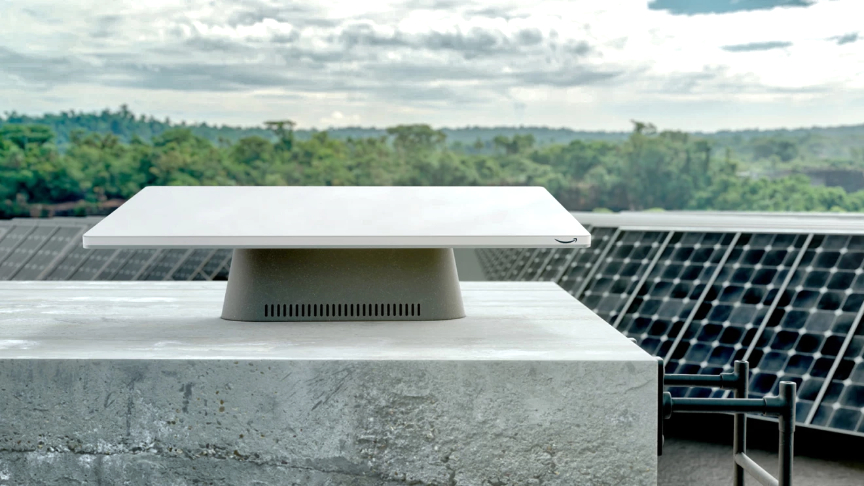
Project Kuiper is Amazon’s LEO satellite network with the mission to bridge the digital divide by providing fast, affordable broadband to communities unserved or underserved by traditional communications technologies.
To use the service, customers will install an outdoor antenna—called a customer terminal—to communicate with satellites passing overhead. Traditionally, this equipment has been too large, too complex and too expensive for many customers, making it difficult for LEO constellations to bridge the digital divide in a meaningful way.
Project Kuiper plans to serve tens of millions of customers, so the company set an ambitious goal at the start of the project: design a customer terminal that costs less than $500 to build. Project Kuiper engineers hit that milestone in 2020, inventing a new antenna architecture that was smaller and lighter than traditional designs. Since then, the team has continued to innovate to make its terminal designs even smaller, more affordable, and more capable.
Amazon has now provided a first look at three engineering models that will anchor its customer terminal portfolio:

- An affordable high-performance design for residential and small business customers: Project Kuiper’s standard customer terminal measures less than 11 inches square and 1 inch thick. It weighs less than five pounds without its mounting bracket. Despite this modest footprint, the device will be one of the most powerful commercially available customer terminals of its size, delivering speeds up to 400 megabits per second (Mbps). Amazon expects to produce these terminals for less than $400 each.
- An ultra-compact design to help connect even more customers: A 7-inch square design will be Project Kuiper’s smallest and most affordable customer terminal. Weighing just 1 pound and offering speeds up to 100 Mbps, its portability and affordability will create opportunities to serve even more customers around the world. This design will connect residential customers who need an even lower-cost model, as well as government and enterprise customers pursuing applications like ground mobility and internet of things (IoT).
- A high-bandwidth design for the most demanding needs: Project Kuiper’s largest, most capable model is designed for enterprise, government, and telecommunications applications that require even more bandwidth. The device measures 19 inches by 30 inches, and will deliver speeds up to 1 gigabit per second (Gbps).
“Our goal with Project Kuiper is not just to connect unserved and underserved communities, but also to delight them with the quality, reliability, and value of their service. From day one, every technology and business decision we’ve made has centered on what will deliver the best experience for different customers around the world, and our range of customer terminals reflects those choices.”
Rajeev Badyal, Amazon’s Vice President of Technology for Project Kuiper

Project Kuiper customer terminals are powered by an Amazon-designed baseband chip, developed under the code name “Prometheus.” Prometheus combines the processing power of a 5G modem chip found in modern smartphones, the capability of a cellular base station to handle traffic from thousands of customers at once, and the ability of a microwave backhaul antenna to support powerful point-to-point connections—and it packs all of that into a single custom chip.
In addition to being in Project Kuiper’s customer terminals, Prometheus is also used in Project Kuiper’s satellites and ground gateway antennas, allowing the system to process up to 1 terabit per second (Tbps) of traffic on board each satellite.
Preparing to offer commercial service
Amazon has built and shipped hundreds of millions of devices for customers, including best-selling, low-cost products such as Echo Dot and Fire TV Stick. Project Kuiper is applying that experience to its customer terminal design and production processes, and the team is already scaling its infrastructure in anticipation of building tens of millions of units for customers.
Project Kuiper is also preparing to deploy its first two prototype satellites on the first flight of United Launch Alliance’s (ULA) Vulcan Centaur rocket. The upcoming mission will help Project Kuiper engineers gain real-world data on how the systems perform in space and let them test the entire end-to-end communications network.
In parallel, Project Kuiper is scaling operations in preparation for offering commercial service. The team recently began development of a dedicated satellite production facility in Kirkland, Washington, and expects to begin mass-producing satellites by the end of 2023.
Project Kuiper expects to launch the first production satellites in the first half of 2024 and plans to give its earliest customers access to the service beginning later that year.
